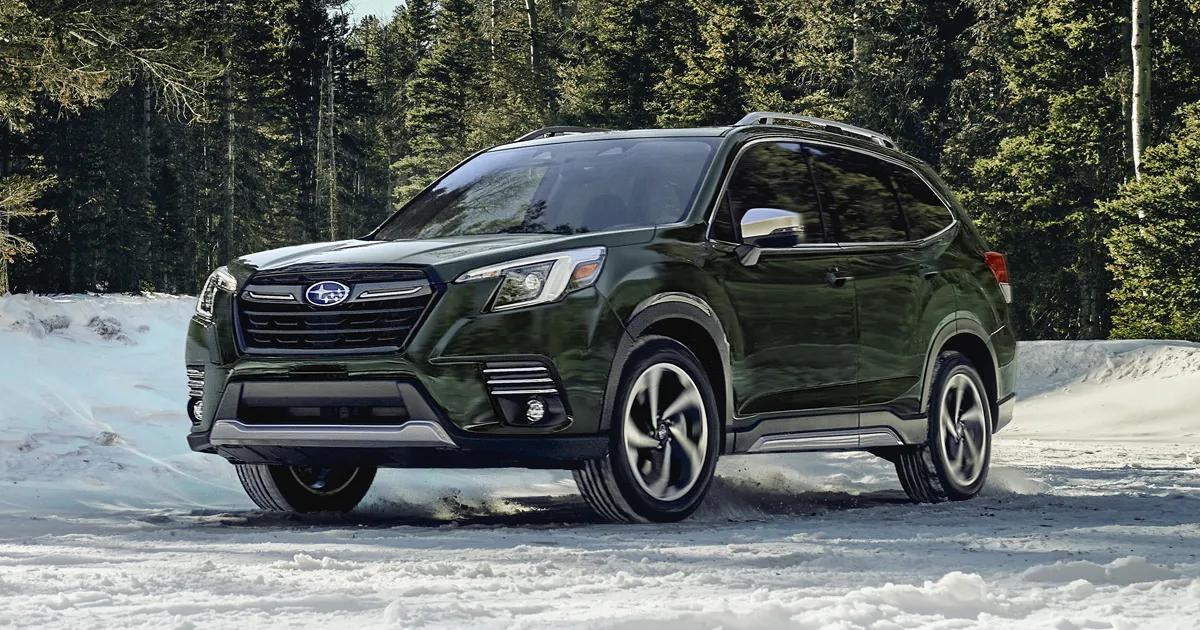Subaru Forester 2023 Cooling System Base
The cooling system of the Subaru Forester 2023 is crucial in maintaining the engine’s temperature and preventing it from overheating. Its main function is to circulate coolant throughout the engine and radiator, transferring the heat generated by the engine to the air outside. The system is composed of various parts, such as the radiator, thermostat, water pump, hoses, and coolant. The radiator, located in the engine compartment’s front, is the most visible part of the cooling system. It has several flat tubes that allow the coolant to flow through and cool down with the air passing over them. The thermostat, situated between the engine and the radiator, controls the flow of coolant based on the engine’s temperature. It remains closed when the engine is cold, preventing the coolant from flowing to the radiator. Once the engine warms up, the thermostat opens, allowing the coolant to flow through the radiator and cool down. The water pump, usually located on the front or side of the engine, circulates the coolant throughout the engine and radiator. It is driven by a belt connected to the engine’s crankshaft. The hoses connect the various parts of the cooling system, allowing the coolant to flow from one component to another. These hoses can deteriorate over time, leading to leaks or other issues. The coolant is a mixture of water and antifreeze that regulates the engine’s temperature and prevents it from freezing in cold weather. It also includes additives that prevent corrosion and lubricate the water pump and other components. Regular maintenance is necessary to ensure that the cooling system functions correctly and prevents overheating. This includes checking the coolant level and condition, inspecting the hoses and belts for wear, and replacing the coolant and other components as recommended by the manufacturer.
2023 Subaru Forester Specs, Price, Features, Mileage (Brochure)
Cooling system
Safety precautions
Never remove the radiator cap until the engine has been shut off and has cooled down completely. Since the coolant is under pressure, you may suffer serious burns from a spray of boiling hot coolant when the cap is removed.
CAUTION
- Vehicles are filled at the factory with SUBARU SUPER COOLANT which does not require the first change for 11 years/137,500 miles (11 years/220,000 km). This coolant should not be mixed with any other brand or type of coolant during this period. Mixing with a different coolant will reduce the life of the coolant. When necessary to add the coolant for any reason, use only SUBARU SUPER COOLANT.
- If the SUBARU SUPER COOLANT is diluted with another brand or type, the maintenance interval is shortened to that of the mixing coolant.
- Do not splash the engine coolant over painted parts. The alcohol contained in the engine coolant may damage the paint surface.
Cooling fan, hose, and connections
Your vehicle employs an electric cooling fan which is thermostatically controlled to operate when the engine coolant reaches a specific temperature. If the radiator cooling fan does not operate even when the coolant temperature high warning light blinks or illuminates in RED, the cooling fan circuit may be defective. If the fuse is not blown, have the cooling system checked by your SUBARU dealer. If the frequent addition of coolant is necessary between vehicle service visits, it is recommended that you have your vehicle inspected by an authorized SUBARU dealer to check for leaks, damage, or looseness.
Engine coolant
Checking the coolant level
WARNING
Never remove the radiator cap until the engine has been shut off and has cooled down completely. Since the coolant is under pressure, you may suffer serious burns from a spray of boiling hot coolant when the cap is removed.
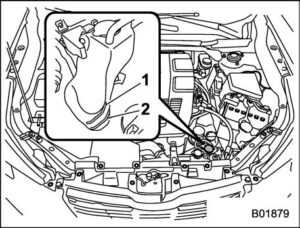
- “FULL” level mark
- “LOW” level mark
Check the coolant level at each fuel stop.
- Check the coolant level on the outside of the reservoir while the engine is cool.
- If the level is close to or lower than the “LOW” level mark, add coolant up to the “FULL” level mark. If the reserve tank is empty, remove the radiator cap and refill the coolant up to just below the filler neck as shown in the following illustration.
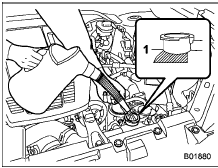
- Fill up to this level.
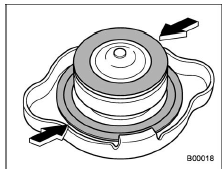
- After refilling the reserve tank and the radiator, reinstall the cap and check that the rubber gaskets inside the radiator cap are in the proper position.
CAUTION
- Be careful not to spill engine coolant when adding it. If coolant touches the exhaust pipe, it may cause a bad smell, smoke, and/or a fire. If engine coolant gets on the exhaust pipe, be sure to wipe it off.
- Do not splash the engine coolant over painted parts. The alcohol contained in the engine coolant may damage the paint surface.
Changing the coolant
It may be difficult to change the coolant. Has the coolant been changed by your SUBARU dealer if necessary? The coolant should be changed according to the maintenance schedule in the “Warranty and Maintenance Booklet”
Air cleaner element
WARNING
Do not operate the engine with the air cleaner element removed. The air cleaner element not only filters intake air but also stops flames if the engine backfires. If the air cleaner element is not installed when the engine backfires, you could be burned.
CAUTION
When replacing the air cleaner element, use a genuine SUBARU air cleaner element. If it is not used, it will have a negative effect to the engine. The air cleaner element functions as a filter screen. When the element is perforated or removed, engine wear will be excessive and engine life shortened. It is not necessary to clean or wash the air cleaner element.
Replacing the air cleaner element
Replace the air cleaner element according to the maintenance schedule in the “Warranty and Maintenance Booklet”. Under extremely dusty conditions, replace it more frequently. It is recommended that you always use genuine SUBARU parts.
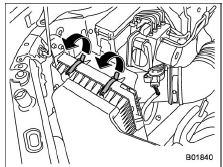
- Unsnap the two clips holding the air cleaner case (rear).
- Open the air cleaner case and pull the cover rearward while lifting it up.
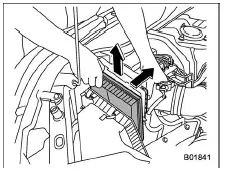
- Remove the air cleaner element.
- Clean the inside of the air cleaner case (both front and rear) with a damp cloth and install a new air cleaner element.
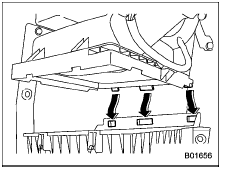
- To install the air cleaner case (rear), insert the three projections on the air cleaner case (rear) into the slits on the air cleaner case (front).
- Install in the reverse order of removal.
NOTE
Install the air cleaner element so that the surface with “UPR” printed on it faces upward.
Spark plugs
It may be difficult to replace the spark plugs. It is recommended that you have the spark plugs replaced by your SUBARU dealer. The spark plugs should be replaced according to the maintenance schedule in the “Warranty and Maintenance Booklet”.
CAUTION
Make sure the cables are replaced in the correct order.
Drive belt
It is unnecessary to check the deflection of the drive belt periodically because your engine is equipped with an automatic belt tension adjuster. However, the replacement of the belt should be done according to the maintenance schedule in the “Warranty and Maintenance Booklet”. Consult your SUBARU dealer for replacement. If the drive belt is loose, cracked or worn, contact your SUBARU dealer.
Continuously variable transmission fluid
It is not necessary to check the transmission fluid level. Check that there are no cracks, damage, or leakage. However, the fluid inspection should be performed according to the maintenance schedule in the “Warranty and Maintenance Booklet”. Consult your SUBARU dealer for details.
Front differential gear oil and rear differential gear oil
It is not necessary to check the gear oil level. Check that there are no cracks, damage, or leakage. However, the oil inspection should be performed according to the maintenance schedule in the “Warranty and Maintenance Booklet”. Consult your SUBARU dealer for details.
Recommended grade and viscosity
Each oil manufacturer has its own base oils and additives. Never use different brands together.
CAUTION
Using a differential gear oil other than the specified oil may cause a decline in vehicle performance.
FAQ
What is the cooling system in the Subaru Forester 2023?
The cooling system is a vital component that helps regulate the temperature of the engine and prevent it from overheating.
What are the components of the cooling system?
The cooling system consists of several parts, including the radiator, thermostat, water pump, hoses, and coolant.
Where is the radiator located in the Forester 2023?
The radiator is usually located at the front of the engine compartment.
How does the radiator work?
The radiator has a series of thin, flat tubes that allow the coolant to flow through and be cooled by the air passing over the tubes.
What is the thermostat?
The thermostat is a valve located between the engine and the radiator that regulates the flow of coolant based on the engine’s temperature.
How does the thermostat work?
When the engine is cold, the thermostat remains closed, preventing the coolant from flowing to the radiator. Once the engine warms up, the thermostat opens, allowing the coolant to flow through the radiator and cool down.
What is the water pump?
The water pump is responsible for circulating the coolant through the engine and radiator.
How is the water pump powered?
It is typically driven by a belt connected to the engine’s crankshaft and can be located on the front or side of the engine.
What are the hoses in the cooling system?
The hoses connect the different components of the cooling system and allow the coolant to flow from one part to another.
What is the coolant?
The coolant is a mixture of water and antifreeze that helps to regulate the temperature of the engine and prevent it from freezing in cold weather.
What are the additives in the coolant?
The coolant contains additives that prevent corrosion and lubricate the water pump and other components.
Why is regular maintenance of the cooling system important?
Regular maintenance of the cooling system is important to ensure its proper function and prevent overheating.
What should be checked during cooling system maintenance?
This includes checking the coolant level and condition, inspecting the hoses and belts for wear, and replacing the coolant and other components as recommended by the manufacturer.
How often should the coolant be replaced?
The coolant should be replaced every 30,000 to 60,000 miles or as recommended by the manufacturer.
Can I use any type of coolant in my Forester 2023?
It is important to use the type of coolant recommended by the manufacturer to ensure proper function and avoid damage to the cooling system.
Useful Link
View Full User Guide: Subaru Forester 2023 Base User Guide
Download Manuals: https://www.subaru.com/owners/vehicle-resources/manuals.html
2023 Subaro Forester Specs, Price, Features, Mileage (Brochure)

